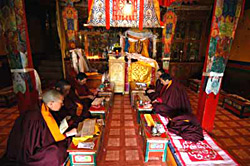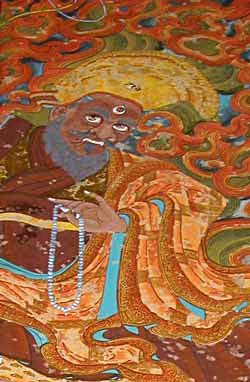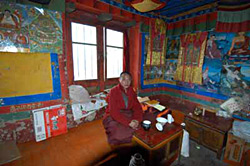by José Ignacio Cabezón and THL.
Life in the SeraSe ra Hermitages
By 1959, almost all of SeraSe ra’s hermitages had been ritual institutions for close to two-hundred years. If a monk who had entered a hermitage wanted to study, he would go to SeraSe ra. If he wanted to do life-long, isolated meditation retreat, he would seek a truly secluded place in the mountains. By the same token, if a SeraSe ra monk did not want to study, and if he was content to lead the life of a ritualist, he could enter a hermitage (if permitted by his regional house and accepted by the hermitage). Of course, a monk who wanted to lead the life of a ritualist could remain at SeraSe ra, but life in a hermitage was often much easier than life in a seat of learning, especially if the hermitage was the seat of a high lamabla ma who was wealthy. Be that as it may, those monks who entered the hermitages knew the type of life they would be living. They would either be engaged in ritual (especially if they had a good voice or knew how to play a musical instrument), or they would serve as support staff for the hermitage: cleaning, tending altars, cooking, doing business on the hermitage’s behalf, or supervising one of its estates.
To become an official monk or nun in one of the hermitages the postulant would have to submit to an examination (gyukrgyugs). By the time monks and nuns were senior members of the institution, they would have memorized close to five-hundred pages of ritual texts.33 Monks and nuns performed the rituals of the hermitage in monthly and yearly ritual cycles in accordance with the institution’s liturgical calendar. If no sponsor was available, the fixed rituals would be “paid for” by the hermitage itself. That is, the monastery would provide the monks and nuns with food (often better than the day-to-day fare) for the duration of the ritual cycle. But local lay people, monks from other monasteries, and the Tibetan government often commissioned rituals – sometimes acting as sponsors for one of the monastery’s own fixed ritual cycles, sometimes requesting the hermitage to perform special rituals on one of its free days. There were, of course, plenty of lay people in the LhasaLha sa Valley and its suburbs who needed such rituals (zhaptenzhabs brtan) to be performed on their behalf. On occasion, a small group of monks or nuns from the hermitage might also be invited to a lay person’s home to do ritual there. Rituals have always been an important source of income for the hermitages and for their individual monks and nuns.
While there is some variation in the monthly and yearly liturgical cycles of the hermitages, there is also a great deal of overlap. Almost all of the hermitages, for example, celebrate the new and full moon days,34 as well as the tenth and twenty-fifth of the lunar month. Some of them also perform protector deity practices on an additional day every month.
There is also a great deal of similarity in the yearly ritual cycle. Monks and nuns perform quite extensive multiple-day ritual cycles during the New Year (LosarLo gsar), and during the “Sixth-Month Fourth-Day” (Drukpa TsezhiDrug pa tshe bzhi) celebrations. This latter holiday, also called “Festival of the Turning of the Wheel of the Doctrine” (Chönkhor DüchenChos ’khor dus chen), is a major pilgrimage day for Tibetans from LhasaLha sa and surrounding areas, as thousands of people travel along a route in the foothills above SeraSe ra from Pabongkha Hermitage in the west to PurchokPhur lcog in the east. A good deal of the hermitages’ income for the year derives from the moneys and in-kind goods collected in the form of offerings on this day (at least if the hermitage is fortunate enough to lie on the pilgrimage circuit). At different times of the year (in the first fortnight of the fourth Tibetan month, for example) the hermitages also perform two-day Avalokiteśvara fasting ritual (nyungnésmyung gnas) – often doing multiple sets of two-day rituals consecutively.35 The hermitages also, of course, celebrate other major pan-sectarian holidays, like the Buddha’s birth/death date, as well as GelukDge lugs-specific holy days like the commemoration of TsongkhapaTsong kha pa’s death – the Ganden Feast of the 25th (Ganden NgamchöDga’ ldan lnga mchod) – that takes place on the twenty-fifth day of the twelfth Tibetan month. All of the hermitages, it seems, also maintained the “rainy-season retreat” (yarnédbyar gnas) tradition, during which monks and nuns minimize their movement for a portion of the summer so as to avoid killing insects that are more prevalent on the ground during this time.
 Nuns perform a Medicine Buddha (MenlaSman bla) ritual for a benefactor at NegodongGnas sgo gdong nunnery |  Detail of a tangkathang ka of Nyang bran rgyal chen preserved in one of the regional houses of SeraSe ra, India. |
Of course, each hermitage has its own set of tutelary deities (yidamyi dam) and protector deities (sungmasrung ma, chökyongchos skyong), and so the rites performed by the monks and nuns may vary from one monastery to the next. But given that all of them are GelukDge lugs institutions, there is also a great deal of overlap in the deities propitiated, and in the actual liturgies performed. Hence, for example, many of the monasteries perform the self-generation (dakkyébdag bskyed) and self-initiation (danjukbdag ’jug) rituals of Vajrabhairava, and they propitiate protector deities like Penden LhamoDpal ldan lha mo, Mahākāla (GönpoMgon po), Dharmarāja (ChögyelChos rgyal), and Vaiśravana (NamséRnam sras). In some monasteries, especially in the hermitages to the west of SeraSe ra, the protector Nyangdren GyelchenNyang bran rgyal chen, the local site-protector of the NyangdrenNyang bran Valley, is also propitiated. The rites written by Pabongkha Dechen NyingpoPha bong kha bde chen snying po (1878-1941) continue to be as popular today as they were before 1959.
As an example, here are the principal ritual practices done at one of the hermitages, Garu Nunnery, in a one-month period (the dates given are the dates in the Tibetan lunar month):
| Date | Ritual Practice (Tibetan) | Ritual Practice (English) |
| 8 |
Drölchok (Sgrol chog) Tungshak (Ltung bshags) |
Tārā Ritual36
The Ritual of the Thirty-Five Confession Buddhas |
| 10 |
Demchok Lachö (bde mchog bla
mchod) Jikjé Danjuk (’Jigs byed bdag ’jug)37 |
Offering to the Master Based on the Deity Cakrasaṃvara
Self-Initiation of Vajrabhairava |
| 15 | Menla Deshek Gyé (sman bla bde gshegs brgyad)38 | Ritual of the Eight Medicine Buddhas |
| 1939 | Gönpo Chögyel Lhamo Namsé dang Nyangdren Gyelchengyi Kangsol (mgon po/ chos rgyal/ lha mo/ rnam sras dang/ nyang bran rgyal chen gyi bskang gsol) | Propitiation Rituals of Mahākāla, Dharmarāja, Vaiśravana, Penden Lhamo, and Nyangdren Gyelchen |
| 25 |
Demchok Lachö (bde mchog bla
mchod)40 Neljormé Danjuk (rnal ’byor ma’i bdag ’jug) |
Offering to the Master Based on the Deity Cakrasaṃvara
Self-Initiation of Vajrayoginī |
| 30 | Neten Chudruk (gnas brtan bcu drug)41 | The Sixteen Arhats Ritual |
In addition to performing rituals, the monks of the male hermitages have traditionally seen it as part of their duties to keep a number of rooms open for visiting SeraSe ra monks. Textualists or pechawadpe cha ba from SeraSe ra’s two philosophical colleges – JéByes and MéSmad – had a number of study breaks between the different study periods,42 and they would often seek the relative peace and quiet of the hermitages, usually not for meditation, but for intensive memorization retreats. This tradition still exists, although today the monks tend to request rooms in the hermitages owned by (and closest to) SeraSe ra rather than seeking rooms in privately-held hermitages like PurchokPhur lcog. Sera UtséSe ra dbu rtse, Sera ChödingSe ra chos sdings, and RakhadrakRa kha brag have always been especially popular with SeraSe ra monks who want to do such retreats not only because of their proximity to SeraSe ra, but also because of the strong associations of these three hermitages with events in the life of TsongkhapaTsong kha pa.

A SeraSe ra monk who in 2004 was engaged in a textual retreat (petsamdpe mtshams) at Rakhadrak Hermitage. He is occupying a room adjacent to the cave of TsongkhapaTsong kha pa.
As with many monasteries in Tibet today, the population of the SeraSe ra hermitages is quite young. The vast majority of the monks and nuns are under the age of thirty, and many are much younger. While the nunneries appear to be thriving, the fate of the male hermitages is not as clear. In pre-1959 Tibet, there were basically only two career options available to young men and women: they either became monks and nuns, or they chose a family life. If they chose the latter and they entered the workforce, they usually followed in the footsteps of their parents, who were either farmers (zhingpazhing pa), nomads (drokpa’brog pa),43 or, less frequently, merchants (tsongpatshong pa). The life of the farmer and nomad was a difficult life. By comparison, the monastic life was more secure, and it provided opportunities for education – and therefore for social and economic advancement – that were not normally available to ordinary villagers and nomads.
Today the situation is quite different. Young men and women have (at least in theory) more choices open to them. Secular education (almost exclusively in the medium of Chinese language) is now a possibility, even if it is still mostly accessible only to the middle and upper classes in urban areas. And there are a variety of career options that were not available before 1959 (mostly for those who are educated and who live in, or who relocate to, larger urban areas). How much opportunity actually exists for Tibetan youths – as important as this question is – is not really the issue we are concerned with here. Rather, what is most important for us as we contemplate the future of institutions like the hermitages is the perception that exists in the minds of young Tibetans about their possible future. In their minds, driven in large part by the visions they absorb from television and films, the world is filled with opportunities, life-choices and lifestyles that compete with the monastic life. But Tibetans are an extremely devout people, and monks and nuns continue to enter the monasteries and nunneries, often with a great sense of religious calling, and with an idealistic vision of what it will be like to live in such an institution. This influx of young Tibetans into small monasteries like the hermitages is not something that one sees changing anytime in the near future. What is changing is what happens after young people (and especially young men) enter monasteries. And here the pattern seems to be that most of the young monks leave the monastery before they are twenty years of age. The problem for the hermitages, then, is not one of recruitment but of retention.44 At least this is the problem in smaller monasteries, and especially in smaller monasteries near a large cosmopolitan area like LhasaLha sa, where, because of its physical proximity, the secular and modern life entices young monks with even greater force.45
An elder monk from one of the hermitages complained to me, for example, that he had “lost” many young boys in their late teens, and that he was considering not accepting boys any longer, his theory being that if one holds out for more mature young men in their twenties (preferably already ordained), one is more apt to get candidates who already know what is in store for them, and who will not be so easily enticed by the lures of the world. It remains to be seen, however, how many monks there are who fit this description and are not already committed to another monastic institution. Or, if such individuals do exist, it remains to be seen how many of them see themselves living out their lives in a relatively isolated, small, ritual monastery. If it is impossible to lure such monks to the hermitages, then the administrators of these institutions may have to resign themselves to the fact that their monasteries will be, for all intents and purposes, something akin to religious boarding schools for young men, the majority of whom will most likely leave once they reach their twenties. But even if they leave, perhaps these young men will return to the hermitages at the end of their life, to live out their final years in a religious setting, a pattern that we have seen in other Tibetan contexts.46 Be that as it may, one thing is clear: life in the hermitages is different from what it was before 1959, and the problems that hermitages face today are as much due to global and market forces as they are to Chinese Communist ideology and bureaucratic regulation.
Hermitages Home
Table of Contents
- Introduction
- Location and Institutional Affiliation to SeraSe ra
- History
- Life in the SeraSe ra Hermitages
- Glossary
- Notes
- Specify View:
- Specify Format:
 |  |  |